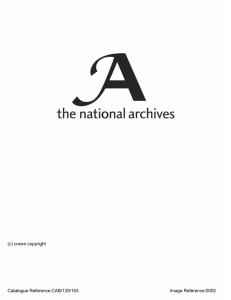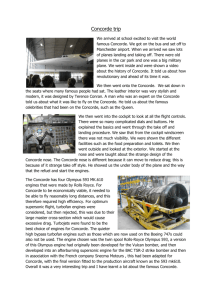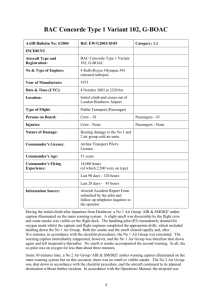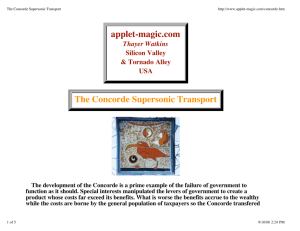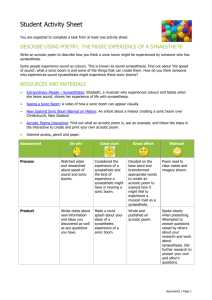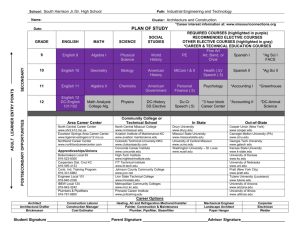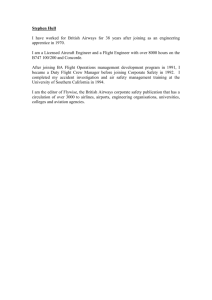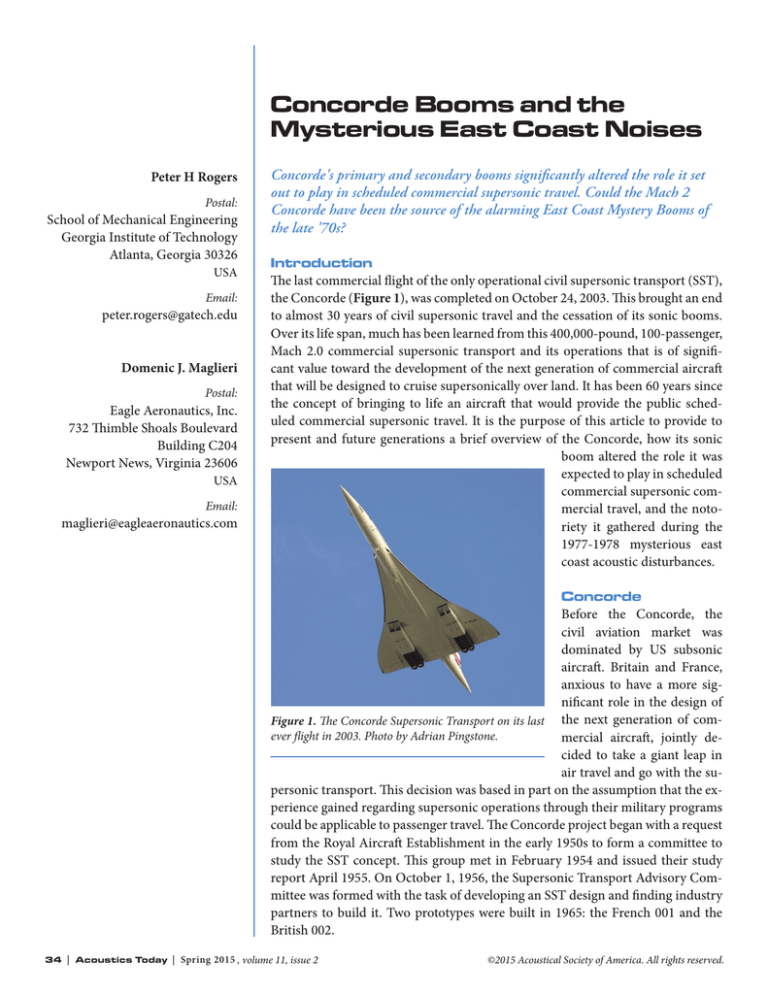
Concorde Booms and the
Mysterious East Coast Noises
Peter H Rogers
Postal:
School of Mechanical Engineering
Georgia Institute of Technology
Atlanta, Georgia 30326
USA
Email:
peter.rogers@gatech.edu
Domenic J. Maglieri
Postal:
Eagle Aeronautics, Inc.
732 Thimble Shoals Boulevard
Building C204
Newport News, Virginia 23606
USA
Email:
maglieri@eagleaeronautics.com
Concorde's primary and secondary booms significantly altered the role it set
out to play in scheduled commercial supersonic travel. Could the Mach 2
Concorde have been the source of the alarming East Coast Mystery Booms of
the late '70s?
Introduction
The last commercial flight of the only operational civil supersonic transport (SST),
the Concorde (Figure 1), was completed on October 24, 2003. This brought an end
to almost 30 years of civil supersonic travel and the cessation of its sonic booms.
Over its life span, much has been learned from this 400,000-pound, 100-passenger,
Mach 2.0 commercial supersonic transport and its operations that is of significant value toward the development of the next generation of commercial aircraft
that will be designed to cruise supersonically over land. It has been 60 years since
the concept of bringing to life an aircraft that would provide the public scheduled commercial supersonic travel. It is the purpose of this article to provide to
present and future generations a brief overview of the Concorde, how its sonic
boom altered the role it was
expected to play in scheduled
commercial supersonic commercial travel, and the notoriety it gathered during the
1977-1978 mysterious east
coast acoustic disturbances.
Concorde
Before the Concorde, the
civil aviation market was
dominated by US subsonic
aircraft. Britain and France,
anxious to have a more significant role in the design of
Figure 1. The Concorde Supersonic Transport on its last the next generation of comever flight in 2003. Photo by Adrian Pingstone.
mercial aircraft, jointly decided to take a giant leap in
air travel and go with the supersonic transport. This decision was based in part on the assumption that the experience gained regarding supersonic operations through their military programs
could be applicable to passenger travel. The Concorde project began with a request
from the Royal Aircraft Establishment in the early 1950s to form a committee to
study the SST concept. This group met in February 1954 and issued their study
report April 1955. On October 1, 1956, the Supersonic Transport Advisory Committee was formed with the task of developing an SST design and finding industry
partners to build it. Two prototypes were built in 1965: the French 001 and the
British 002.
34 | Acoustics Today | Spring 2015 , volume 11, issue 2
©2015 Acoustical Society of America. All rights reserved.
supersonic transport in regular passenger service. Like it or
not, the Concorde is a remarkable airplane. It reduced the
trip times between continents to one-half of those of the best
subsonic jet transports, an accomplishment that would have
been cheered in bygone years. The Concorde is perhaps the
world’s most tested transport airplane and, in its operations
to date, has experienced no major accidents and has had no
passenger fatalities.”
Figure 2. Nature of the sonic boom ground footprint for a transatlantic flight by the Concorde. See text for description. ∆p , Difference
between the sonic boom pressure and the ambient pressure. From
Maglieri et al. (2014).
The French aircraft flew supersonic on October 1, 1969. In
the interim, development costs had increased significantly.
This, along with the cancellation of the US SST in 1971 and
the oil crisis in 1973 (Concorde’s fuel consumption was
about 16 passenger miles per gallon compared with about 54
passenger miles per gallon of fuel for the Douglas DC-10),
resulted in only 20 aircraft being built; 6 were prototypes
and the other 14 Anglo-French-built Concordes were placed
in commercial service with 7 each being assigned to British
Airways and Air France.
Since the first commercial passenger carrying flight in 1976,
these 14 aircraft flew a combined total of some 240,000
hours. The highest number of hours flown by any one Concorde per year was 926, which is low in comparison to some
2,000-3,000 hours flown by subsonic long-haul transports. It
is estimated that one-third of all Concorde flight hours were
flown at Mach 2. Thus, the Concorde fleet would have accumulated some 80,000 supersonic flight hours, more than the
combined total of all of the world’s military aircraft.
Much has been written about the Concorde highlighting
high-ticket, operational, and maintenance costs; low utilization; high development and subsidy costs; its sonic boom;
and its excessive airport community noise. However, as
stated by McLean (1985, p. 58), “In spite of being cast as a
transportation ‘heavy’ by critics around the world, the British/French Concorde ranks as one of the foremost technical
achievements that has ever been made. The two nations that
developed this aircraft not only spoke different languages,
but also used different measurement systems. Yet, out of this
unusual alliance came the first and, so far, only commercial
Concorde’s exemplary safety record ended tragically with
the crash of Air France flight 053 on July 25, 2000 (Riding,
2000). The accident marked the beginning of the end for the
Concorde and commercial supersonic travel.
Sonic Boom Footprint
Considerable criticism about the Concorde derived from
the sonic boom trail it imposed along the ground during its
supersonic flight. The nature of the sonic boom ground footprint for a flight such as that of the Concorde, during which
the aircraft cruises supersonically for a large portion of the
distance, is shown in Figure 2. Two ground exposure patterns in which booms are observed are shown.
The primary sonic boom “carpet” is the region on the ground
ensonified by the part of the sonic boom that propagates directly downward from the aircraft to the ground. It begins
with the transition focus boom region resulting from acceleration of the aircraft from subsonic to supersonic speeds.
This focus is a one-time occurrence; it does not move with
the aircraft and is unavoidable. It is followed by the N-wave
boom signatures produced during the climb-and-cruise
phase of flight. (The pressure waveform of the carpet boom
has the shape of the letter “N” as seen in Figures 2 and 3.)
The primary carpet booms are observed shortly after the
passage of the aircraft and result from wave propagation
through only that part of the atmosphere below the aircraft.
The secondary boom “carpet” is the region on the ground
ensonified by the boom that initially goes upward from the
aircraft but is refracted back to the ground by winds in the
stratosphere above the plane. Between the primary and secondary carpets exists a region in which no booms are observed. The secondary booms arrive some 10-15 minutes after the passage of the aircraft, and these disturbances tend to
be very weak in intensity (on the order of 1-10 pascals versus
around 100 pascals for the primary booms) but persist over
longer periods of time (on the order of 5-10 seconds).
The manner in which the atmosphere above and below the
aircraft is involved in developing the primary and secondary
boom carpets is shown in the ray diagram in Figure 4. On
| 35
Concorde Booms and the
Mysterious East Coast Noises
Figure 3. Comparison of Concorde primary and secondary sonic boom signatures and
spectra. One pound per square foot (psf) equals 47.88 pascals. Adapted from Holbeche
(1972) and Rickley and Pierce (1980).
the right side of Figure 4 are examples of temperature and
wind profiles for a given atmosphere. Note that there is a
portion of the higher atmosphere in which the temperature
increases as the altitude increases, and the associated wave
propagation speed thus increases compared with that in the
lower portions of the atmosphere, causing upward propagating rays to be curved (refracted) back toward the ground.
The wind speed gradient will also influence refraction and
may reinforce, or counteract, the effects due to temperature
gradient.
Figure 4. Ray path diagram in plane normal to that of flight illustrating the manner in which the atmosphere above and below is involved
in developing the primary and secondary boom carpets. One nautical
mile equals 1.852 kilometer. From Maglieri et al. (2014).
36 | Acoustics Today | Spring 2015
On the left side of Figure 4 is a ray diagram
showing a variety of ray paths that the
booms travel for an aircraft in supersonic
flight at an altitude of 18 kilometers, traveling toward the viewer. The downwardpropagating rays, shown by the solid lines,
impact the ground to form the primary
boom carpet, as in Figure 4. At a lateral
distance of about 40 kilometers (25 nautical miles) in the example shown, the rays
refract away from the ground and thus define the lateral extent of the primary boom
carpet. Also indicated is a secondary boom
carpet at about 120-160 kilometers from
the flight track, in which the dashed-line
rays impact. These dashed-line rays arrive
in two different ways: either they travel directly to the secondary carpet as a result of
bending in the upper atmosphere or they
may first be a part of the primary carpet,
reflect upward from the surface, and then
bend downward after traveling through a
portion of the upper atmosphere.
Early on in the development of the Concorde, there was serious concern that its primary carpet boom levels would be
too excessive to allow overland supersonic operations. Early
commercial flight operations eventually proved this to be the
case. Concorde supersonic flying would henceforth be confined to overwater operations, primarily Atlantic routes, due
its limited range, thereby limiting utilization of the plane.
On the other hand, the booms near the lateral cutoff and
the secondary booms, which do not have an N-wave character and are much lower in intensity, are not apt to be the
source of serious community response problems. Near the
lateral cutoff, primary booms usually resemble low rumbles
or rolling thunder. Secondary booms, however, are generally
not audible (0.1-1.0 hertz) but can cause building vibrations
that are readily felt. It will be shown later in this article that
secondary booms also played an influential role in further
defining Concorde’s operating procedures.
Secondary Sonic Booms
Secondary booms, also referred to as “over-the-top” booms,
were more of an unknown quantity during the design-anddevelopment days of the Concorde. They too, like primary
booms, are inherent to supersonic flight. The distinct differences between secondary and primary boom signatures
Figure 5. Map showing the inbound and outbound flight paths of
Concorde into Washington Dulles International Airport, VA. Inset
shows schematic ray tracing indicating ray paths through the stratosphere (~40-50 kilometers) and the thermosphere (100-130 kilometers). From Balachandra et al. (1977).
may be seen with the aid of Figure 3. The top left of Figure 3
shows the cruise carpet boom signature from the Concorde
and to the right is the resulting secondary boom signature. Note that the Concorde secondary boom is considerably lower in overpressure and frequency than the primary
boom.
A further indication of the significant difference between
the secondary and primary boom signatures may be obtained by comparing their frequency spectra as shown in the
lower portion of Figure 3. The primary N-wave boom spectrum contains a considerable amount of energy out beyond
1,000 hertz (Holbeche, 1972), whereas the secondary boom
energy is confined to frequencies below ~50 hertz (Rickley
and Pierce, 1980).
One of the earliest observations of secondary booms occurred during controlled NASA sonic boom flight tests over
Wallops Island, VA, in July-August of 1959 (Lina and Maglieri, 1960). Microbarograph measurements were recorded
some 195 kilometers distant.
In 1974, Liszka (1978) carried out an unpublished flight
experiment to measure the secondary booms from a small
supersonic aircraft that propagated 600-900 kilometers.
During the winter months of 1976-1977 and 1977-1978, the
Concorde infrasonic signals (secondary booms) were recorded regularly at measurement stations in northern Sweden at distances up to 5,000 kilometers from the Concorde
flights between the United States and Europe. Relatively
high signal amplitudes up to 0.1 newtons per square meter
were observed.
Figure 6. Typical temperature profile for the atmosphere based U.S.
Standard Atmosphere, 1976. From NASA (1976).
It was reported by Lessen and Pryce (1978) that during the
fall of 1976 and thereafter, noises were heard, mostly indoors, in the southwest part of England, the majority of these
occurring about 9:30 p.m. The regularity of the noises suggested that they were from inbound Concorde flights. The
study showed that the sounds leaving the aircraft in an upward and downward direction were influenced by the temperature and winds in the upper atmosphere. The authors
eventually developed ray-tracing techniques to delineate the
carpet booms.
In 1976, the issue of Concorde booms over the southwest of
England was discussed in great detail in the House of Commons by Penhaligon (1978). The noise had been described
as secondary booms. He reminded the ministers that it was
indicated that the boom skirt would be no more than 20 kilometers wide (referring to the primary boom carpet), yet
the same booms were heard at places 65-80 kilometers apart.
It was also stated that virtually all of the complaints were
made about inward flights and he asked that the Concorde
slow down earlier. He was informed that such a change in
operations would increase fuel use, resulting in a load factor
penalty of some 12 passengers.
On the US side, shortly after the Concorde entered into
commercial service in mid-1976, strange, sharp acoustic
impulses were recorded by Balanchandra et al. (1977) with
the low-frequency array of microphones at the LamontDoherty Geological Observatory, Palisades, NY, and from
Durham, NH. The arrival times of the signals correlated well
with Concorde arrivals. Figure 5 shows the Concorde flight
paths in and out of Washington Dulles International Airport
(Balanchandra et al., 1977). Altitude and Mach number are
marked on the tracks. Points A, B, and C are average source
| 37
Concorde Booms and the
Mysterious East Coast Noises
locations for the three signals recorded at Palisades, NY.
Acoustic signals were recorded on both the inbound and
outbound flights at Durham, NH. Of interest is the schematic ray tracing, shown in the upper left inset in Figure 5,
that indicates ray paths through the stratosphere (about 4050 kilometers) and the thermosphere (100-130 kilometers).
The received signals associated with propagation through
the stratosphere were much stronger than those propagating
through the thermosphere. A typical temperature profile for
the atmosphere illustrating the various atmospheric layers is
shown in Figure 6.
The Mysterious East Coast Booms
The secondary sonic booms went essentially unnoticed in the
United States until 1977 when mysterious east coast acoustic
disturbances were reported (Shapely, 1978). These mysterious sounds were observed from December 2, 1977 through
February 15, 1978, principally in the Charleston, SC, area
and on the New Jersey coast. People were saying they heard
booms, some low rumblings, and other explosive sounds. A
number of suggested causes were put forth that ranged from
methane gas bubbles venting from faults in the ocean's floor
to lasers being beamed from Russian space platforms. Predictably, the January 24, 1978, issue of the National Enquirer
carried a front-page banner headline proclaiming Mystery
Blasts Linked To UFOs. One of the things that fueled the intense interest and concern about these events was the persistent suggestion that they might be a precursor to a major
earthquake. This was particularly troubling to residents of
Charleston because the city was struck by a huge earthquake
in 1886. On December 28, 1977, the Department of Defense
tasked the Naval Research Laboratory (NRL) to carry out
a 60-day intensive investigation to determine the cause of
these startling acoustic events.
According to citizen reports, the disturbances, most frequently observed indoors, included window rattles and
house vibrations, with the noise consistently identified as
coming from the direction of the ocean. Acoustic and seismic measurements of these disturbances were being made at
the Lamont Observatory and at the Weston Observatory at
Boston College (see Figure 5) observatories. Analysis of the
Weston data showed that nearly all the signals occurred on
workdays. Signals were rarely detected on Saturdays, Sundays, or national holidays or during nonworking hours. This
temporal pattern strongly suggested that the events were due
to human activity. The NRL's investigation of possible causes
38 | Acoustics Today | Spring 2015
led them to rule out man-made causes such as military research and development activities, military ordnance, civilian use of high explosives, missile reentry, and low-altitude
satellites. Natural phenomena such as meteorites, winter
lightning, biogenic and tectonic methane, and direct seismic
generation were thoroughly reviewed and classified as unlikely causes of the events, even without consideration of the
their temporal pattern.
The NRL then focused on military operations. They found
that there were military aircraft capable of supersonic flight
in all of the warning areas adjacent to the New Jersey and
South Carolina coastlines. Sonic booms from supersonic
operation in these warning areas were not usually a concern
to residents because the primary booms do not propagate
to the coast under normal atmospheric conditions. Ray
tracings based on atmospheric conditions existing on the
same day that supersonic flights were made showed that the
booms should be observable as far away as 100 kilometers
for flights above 5,000 meters.
The NRL examined the Concorde flights in and out of John
F. Kennedy International Airport (New York) and Washington Dulles International Airport and found no correlation
between their operation and the reported acoustic events in
New Jersey and Charleston, SC. In its March 3, 1978, early
release of the findings (final report, NRL, 1979), the NRL
stated that the most likely source of these events appeared to
be high-performance military aircraft operating supersonically and that the degree of disturbance to the citizens was
influenced by atmospheric propagation conditions.
There was immediate disagreement with the NRL conclusions from Jeremy Stone, president of the Federation of
American Scientists (Shapely, 1978; Sullivan, 1978), who
suspected that somehow, despite evidence to the contrary,
the east coast booms were due to the Concorde. Probably
the strongest reason to suspect the Concorde was the timing
of the onset of the east coast booms. The NRL report (1978)
states that no events were observed at Weston in November
“until November 28 when five events appeared as though a
switch had been thrown.” Concorde service to New York began on November 22, 1977. Stone enlisted the help of IBM
physicist Richard Garwin, a National Medal of Science winner, to come up with a plausible way in which a sonic boom
could travel faster than the aircraft that generated it. According to geometrical acoustics, the upward going sonic booms
(both the one that goes directly up and the one that reflects
from the water) will turn and return to earth when it reaches
Concorde was a technological
marvel that astounded the world
with its beauty and speed. Its sonic
boom was its Achilles heel, but was
it the cause of those mysterious
east coast noises?
an altitude where the local sound speed is equal to the speed
of the aircraft. Because the sound speed is proportional to
the square root of the absolute temperature, this requires
a temperature four times the temperature at the altitude of
the Mach 2 Concorde. The required temperature would be
reached in the thermosphere at an altitude of 160 kilometers (see Figure 6). Garwin (1978) hypothesized that what
he called a “hyperboom,” somehow got detached from the
aircraft when it maneuvered and propagated at a very high
altitude at a speed faster than that of the aircraft and could
reach the US coast over an hour before the aircraft. Moreover, Garwin, a longtime opponent of the Concorde (Sullivan, 1978), also hypothesized that the thermospheric waves
could negatively alter the tenuous thermosphere, thereby
causing chemical reactions and winds (Garwin, 1978).
At the March 8 meeting, the NRL was tasked by Adams and
Press to investigate the Stone-Garwin hypothesis, that is,
specifically to determine what does happen to the upward
going Concorde sonic boom as it propagates to and from its
turning point in the thermosphere. Adams also requested
that Press arrange for an independent review of the Navy’s
results.
The NRL assigned the task to Peter Rogers and John Gardner. Rogers and Gardner developed a model for the thermospheric propagation of the sonic boom from Concorde
aircraft. In the model they considered, only those booms
that were refracted to the ground by the sound velocity gradient in the thermosphere (above 100 kilometers). From
their model, they determined the boom strength as a function of altitude and the ground pressure both on and off the
flight path. The model utilized a realistic atmospheric model
of the density, temperature, and composition of the atmosphere versus altitude and included nonlinear stretching and
attenuation of the wave, the effects of the turning-point and
linear acoustic attenuation. The results are presented in Figure 7 (Rogers and Gardner, 1980). Figure 7 shows the predicted ground pressures for the initially upward and initially
On March 8, 1978, in a meeting attended by Presidential Sci- downward waves as a function of distance from the ground
ence Advisor Frank Press, Transportation Secretary Brock track. The abrupt lateral cutoff was determined by the reAdams, NRL Director Alan Berman, Stone, and Garwin turning rays, which were refracted upward before reaching
charged that the NRL had erred and that the Concorde was the ground. The solid lines show the results, which considthe culprit
in theand eastsymbols coast booms
also may
be causing ered both nonlinear effects and linear attenuation, whereas
In-­‐line equations pg. 13 -­‐and
Concorde Booms the destruction of the thermosphere. In-­‐line equations and symbols pg. 13 lines
-­‐ Concorde Booms the dashed
show the
results obtained using the nonlin was based on the conser- ear theory alone. The dominant signal was from the initially
Garwin’s environmental argument
In-­‐line equations nd symbols 13 -­‐ Concorde ooms Booms In-­‐line eaquations and psg. ymbols pg. 13 -­‐ CBoncorde In-­‐line e
quations a
nd 2 symbols pg. 13 -­‐ Concorde Booms number
vation
#1 of
#2 M acenergy.
= v / c =The
p / ρacoustic
c Mach
v of a sound wave downward wave. The highest pressure level (about 0.30 pas 2
#1 of
aMsound
occurred
#2 about
c = p / ρ ccals)
v 400 kilometers from the ground track.
measure
of the strength
is a dimensionless
ac = v /wave,
The
pressure
measured
on the ground track was a minimum
of the effect
#3 M ac (zTPbe
)/ M
which would
indicative
of the wave on its enac (0) 2
2
was about
M ac #=
/ c#3 c/ cac (z
v #2 1 v by
and
M
= TPp )/ /ρM
c #2 v 0.10 pascals for the initially downward wave.
vironment.
ac ,(0)
#1 In
given
#2 = acp /=vρ vM
M acthe
= vfar
/ c =field,
p /#ρ1 cit 2 is
This
is
because
the ray paths along which the shocks propa particle velocity.
Garwin’s model
(0)the
/ ρ (zacoustic
#4 where vρis
TP ) #3 was proportional
M ac#3 (zTP ) /#4 M acac(0)
(z
M ac/(0)
ρ (z TP ), gate were less steeply inclined at lateral locations compared
#3 that M ac (zTP ) / M ac (0)
showed
toTP )ρ/ (0)
with the on-track rays. Thus, on-track rays traveled to much
#5 z
where TP is the altitude at the turning point.
ρ#4 (0) / ρ #5 (zTPρ)(0)
higher altitudes where they incurred much larger losses due
/zTP
ρ (z TP ) ρ (0) / ρ (zTP ) #4 #4 For theMMach
2 Concorde at the turning
point (160 kilome- to the extremely low density at altitude. It should be noted
#6 ac -12
per
the density
is 1.14 ×
#6 #5 10 zgrams
ters),#5 Mcentimeter,
zTPcubic
ac TP#5 that the predicted secondary boom levels that arrived from
zTP more than nine orders of magnitude
smaller
than
it is on the the thermosphere were more than an order of magnitude less
ground, resulting in a very#6 Maltitude.
large M ac#6 Garwin’s than the secondary boom levels propagated from the strato at that
M ac #6 In caption for Facigure 2 effect of spreading
linear model included the
of the conical sphere and lower mesosphere (see Figures 3 and 7). This is
In caption for Figure 2 wave front
#7 Δp but was subject to criticism because it did not in contrast to the primary carpet booms where the pressure
nonlinearity, refraction,
include
linear
attenuation,
the was a maximum (about 100 pascals) along the ground track
#7 f2
and
for Figure Δp
caption or Figure 2 In caption for Figure In 2 caption In focusing at the turning-point
caustic
where adjacent rays and decreased to zero at the lateral cutoff.
cross.#7 #7 Δp
#7 Δp Δp Rogers and Gardner (1980) concluded that thermospheric
returns from the Concorde are of sufficiently low amplitude
| 39
Concorde Booms and the
Mysterious East Coast Noises
Rogers and Gardner concluded that the secondary booms
from the Concorde did not have sufficient amplitude or energy to produce a deleterious effect on the thermosphere.
Figure 7. Relative strength on the ground from a sonic boom returning from the thermosphere as a function of the lateral distance from
the aircraft ground track. Adapted from Rogers and Gardner (1980).
and frequency that it is unlikely that they are either responsible for the east coast events or likely to disturb the public.
With regard to Garwin’s destruction-of-the-thermosphere
hypothesis, results for acoustic Mach number versus altitude
for Garwin’s model and the Rogers and Gardner model are
plotted in Figure 8. The red curve is Garwin’s model, and
the black solid line includes only nonlinear attenuation. The
black dashed line includes both linear (L) and nonlinear
(NL) attenuation. The acoustic Mach number for the Rogers
and Gardner model never exceeds 0.2. Ninety percent of the
wave's energy is attenuated below 100 kilometers, with 99%
attenuated by the time the wave reaches the turning point.
Figure 8. Acoustic Mach number versus altitude for initially downward sonic boom from Concorde. Red line, Garwin's (1978) model;
solid line, Rogers and Gardner (1980) model including nonlinear
losses only; dashed line, Rogers and Gardner model including both
linear and nonlinear losses. Adapted from Rogers and Gardner
(1980).
40 | Acoustics Today | Spring 2015
Rogers and Gardner completed their model in June of 1978.
Press’s process for an independent review of their work involved the JASONS who were asked to look into the problem, The JASON team, which included Garwin, developed
a simple plane wave model that included only nonlinear
stretching and attenuation (no spreading, caustics refraction, or linear attenuation). Despite its simplicity, the JASON
model (MacDonald et al., 1978) produced results consistent
with those of Rogers and Gardner. They concluded that Rogers and Gardner’s results and conclusions were correct.
Upper Atmospheric Sound Speed
Secondary sonic boom events in the form of “thumps” and
low-frequency “rumbles” were once again reported in the
New England area during the summer of 1978. Preliminary
measurements by the Department of Transportation, Transportation System Center (DOT/TSC) (Rickley and Pierce,
1979) suggested some correlation with incoming Concorde
flights into John F. Kennedy International Airport. In the
summer of 1979, a secondary sonic boom detection and assessment program was conducted by the US DOT/TSC in
New England (Rickley and Pierce, 1980). A large database
of measurements was obtained regarding secondary booms.
The results of these tests showed that the upper atmospheric
temperature and winds along with the aircraft operating
conditions played an important role in whether and where
the secondary booms will impact the ground. It is stated that
a principal mechanism causing such long distance effects is
refraction caused by wind and temperature gradient effects
at altitudes between 20 and 60 kilometers (the stratosphere)
and mesosphere (see Figure 6). Sound waves that carry upward traveling sonic booms to such altitudes can be bent
back toward the ground if these gradients cause the sound
speed to increase with altitude. Such downward refraction can also take place in the thermosphere, but the high
attenuation and lengthening of the shock duration at high
altitudes would render such thermospheric refracted arrivals much less likely to be audible by the time they return to
the ground. This is consistent with the conclusions of Rogers
and Gardner (1980).
Rickley and Pierce (1980) applied the simplest model of
sonic boom propagation based on geometrical acoustics that predicts that secondary booms will reach the
turbances, which are propagated upward to the stratosphere
and lower mesosphere and refracted back downward to the
ground, are an order of magnitude higher in amplitudes
than the boom returns from the thermosphere and are observable not only by persons located indoors but also by
those located outdoors.
In every case of complaints about Concorde-generated
secondary sonic booms, rerouting of the flight tracks, and
changes in operational conditions depending on atmospheric and seasonal variations, mitigated the problem, especially in
earlier deceleration to Mach 1 before the coastline was reached.
Figure 9. Effective sound speed profiles, Boston, MA, June 20, 1979,
1200 hours. From Rickley and Pierce (1980).
ground only when the wind velocity in the direction of
propagation and the sound speed, including the wind velocity in the direction of propagation at an altitude above the
flight altitude, exceeds the corresponding seen at the ground
as shown in Figure 9. Examination of Figure 9 shows that
strong winds at heights from 30 to 60 kilometers blowing
east to west that are in the same direction as the Concorde
incoming flight track will result in their being secondary
booms in the Boston area. This hypothesis was tested and
the results indicated that the probability of receiving a large
amplitude event is small unless the east-to-west wind speed
in the stratopause exceeds 16 meters per second. (The stratopause is the region of the atmosphere where there is a local
temperature, and hence, sound speed maximum; see Figure 6.)
Aircraft Operations
Relatively minor variations in the incoming Concorde arrival flight paths and operating conditions can alter the location of impact of the secondary booms. Computed secondary boom focus line sources using the TSC computational
program (Rickley and Pierce, 1980) show that slight variation in Concorde flights results in a shift in the secondary
boom footprints by 40 kilometers. The measurements and
ray-tracing computations demonstrated that the secondary
booms frequently reported by New England residents were
created by the Concorde flights off the New England coast
en route to John F. Kennedy International Airport in New
York. A brief set of measurements made in Applebachsville,
PA, also correlated with Concorde flights into Washington
Dulles International Airport in Virginia. These boom dis-
Concluding Remarks
The Concorde was a technological marvel that astounded the
world with its beauty of design and speed, halving passenger flight times to distant destinations. However, it was not
a financial success due to high operating and maintenance
costs and low utilization. The low utilization was because its
primary sonic booms and limited range confined its operations to trans-Atlantic routes. Even for trans-Atlantic routes,
low-amplitude secondary booms, reaching the ground from
the upper atmosphere by refraction, resulted in further restrictions on the operations of the Concorde.
The Concorde was absolved of responsibility for the east
coast booms. Although it is agreed that the majority of the
east coast booms were due to high performance military
aircraft operating offshore, many of the events cannot be
explained in this way (Eos, 1978). The East Coast Mystery
Booms remain a mystery to this day.
Biosketches
Peter H Rogers received an SB in
physics from MIT in 1965 and a PhD
from Brown 1970. He worked at the
Naval Research Laboratory as a Research Physicist and at ONR as Scientific Officer for Underwater Acoustics before joining the School of
Mechanical Engineering at Georgia
Tech in 1983. He became the Rae & Frank H. Neely Chair
in 1993. He is a fellow of the Acoustical Society of America
and received its Biennial Award (now the R. Lindsay Award)
in1980 based largely on the work reported in this article.
| 41
Concorde Booms and the
Mysterious East Coast Noises
Domenic J. Maglieri graduated from
the University of Pittsburgh in 1951
with a B.S. degree in ME/AE and began his career at National Advisory
Committee for Aeronautics (NACA)
doing research on aircraft noise control and sonic boom. He retired from
NASA in 1986 and joined Eagle Aeronautics as Director for Projects. His
sonic boom involvement began in 1957 and has continued to
the present, participating in every major sonic boom flight
test program. He authored or co-authored over 160 publications, 100 are on sonic boom. He is an ASA Fellow, a Board
Certified Member of the INCE and an AIAA Associate Fellow.
References
Balachandra, N. K., Donn, W. L., and Rind, D. H. (1977). Concorde sonic
booms as an atmospheric probe. Science 197, 47-49.
Eos. (1979). New investigation of east coast mystery booms. Eos, Transactions American Geophysical Union 60, 49. Available at http://onlinelibrary.
wiley.com/doi/10.1029/EO060i005p00049-02/epdf.
Garwin, R. L. (1978). Speculation on Long-Range Effects of Supersonic Flight.
Unpublished note.
Holbeche, T. A. (1972). Measurements of Sonic Bangs from the Prototype
Concorde 002 During Supersonic Development of Flying in the United Kingdom. Technical Memorandum Aero 1405, Royal Aircraft Establishment.
Lessen, M., and Pryce, A. W. (1978). Now don't get rattled. Journal of
the Acoustical Society of America 64, 1727. Available at http://dx.doi.
org/10.1121/1.2033228.
Lina, L. J., and Maglieri, D. J. (1960). Ground Measurements of Airplane
Shock Wave Noise for Mach Numbers to 2.0 and Altitudes to 60,000 ft.
42 | Acoustics Today | Spring 2015
Technical Report NASA TN-D-235, National Aeronautics and Space Administration, Washington, DC. Available at http://catalog.hathitrust.org/
Record/011445564.
Liszka, L. (1978). Long-distance focusing of Concorde sonic boom. Journal
of the Acoustical Society of America 64, 613-635.
MacDonald, G., Flatté, S., Garwin, R., and Perkins, F. (1978). JASON 1978
Sonic Boom Report. Technical Report JSR-78-09 (AD A0 65294), Stanford
Research Institute International, Arlington, VA. Available at http://fas.org/
irp/agency/dod/jason/sonic.pdf.
Maglieri, D., Bobbitt, P., Plotkin, K., Shepherd, K., Coen, P., and Richwine,
D. (2014). Sonic Boom: Six Decades of Research. NASA/SP-2015-622, National Aeronautics and Space Administration, Washington, DC.
McLean, F. E. (1985). Supersonic Cruise Technology. Technical Report NASA SP472, National Aeronautics and Space Administration, Washington, DC.
NASA. (1976). U.S. Standard Atmosphere,1976. Government Printing Office, Washington, DC. Available at http://ntrs.nasa.gov/archive/nasa/casi.
ntrs.nasa.gov/19770009539.pdf.
Naval Research Laboratory (NRL). (1978). NRL Investigations of East Coast
Acoustics Events, 2 December 1977-15 February 1978. Naval Research Laboratory, Department of the Navy, Washington, DC.
Penhaligon. (1978). Concorde (Sonic Boom). The Official Report, House of
Commons, 5th Series, 946, 1773-1788.
Rickley, E. J., and Pierce, A. D. (1979). Detection and Assessment of Secondary Sonic Booms in New England. DOT-TSC-FA953-PR-79-2, Department of Transportation, Washington, DC. Available at http://ntl.bts.gov/
lib/35000/35100/35186/DOT-TSC-FAA-80-10.pdf.
Rickley, E. J., and Pierce, A. D. (1980). Detection and Assessment of Secondary Sonic Booms in New England. FAA-AEE-80-22, Federal Aviation Administration, Department of Transportation, Washington, DC.
Riding, A. (2000). Concorde Crash: The Overview; 113 Die in First Crash of
a Concorde. The New York Times, July 26, 2000, A1.
Rogers, P. H., and Gardner, J. H. (1980). Propagation of sonic booms in the
thermosphere. Journal of the Acoustical Society of America 67, 78-91.
Shapely, D. (1978). East coast booms: A scientific suspense tale. Science 199,
1416-1417.
Sullivan, W. (1978). Scientist Says Data Uphold Thesis Tying Concorde to Coastal Booms U.S. Will Investigate. New York Times, March 16, 1978, B16.

